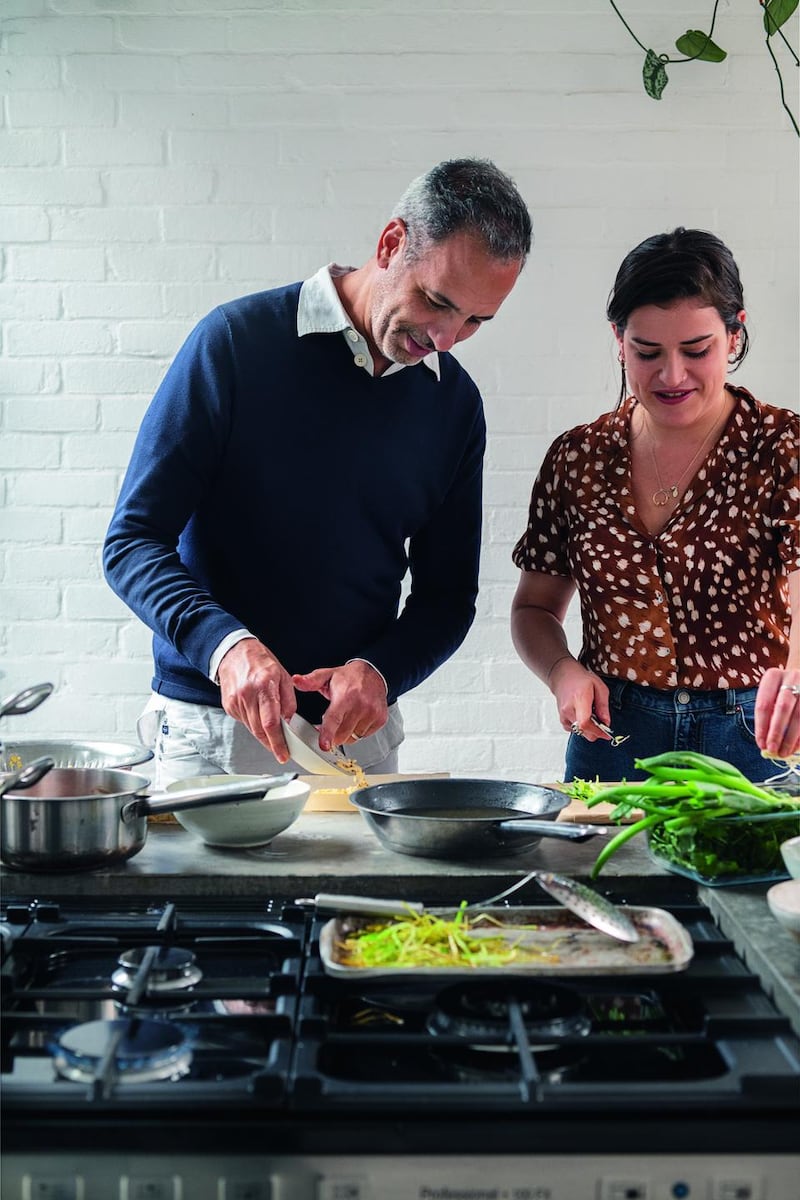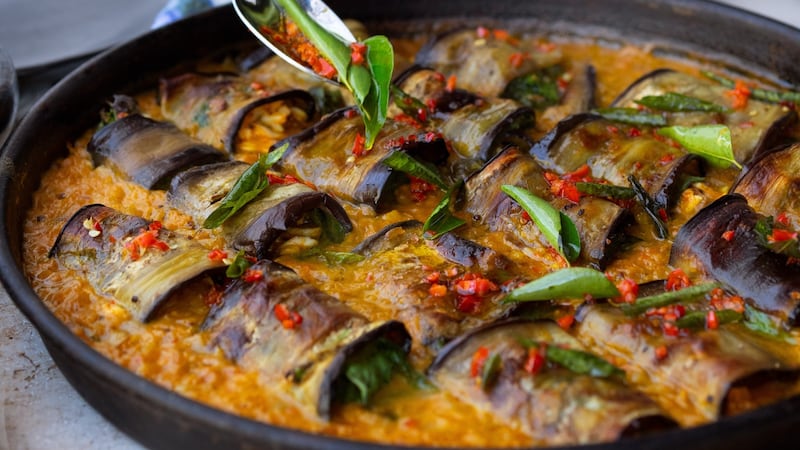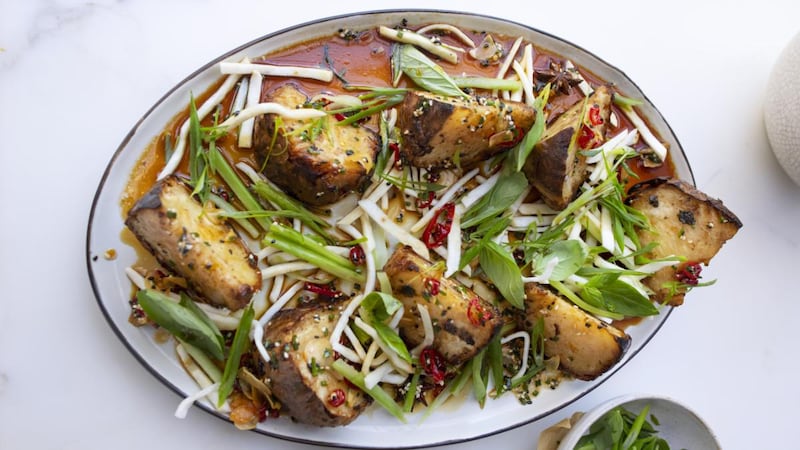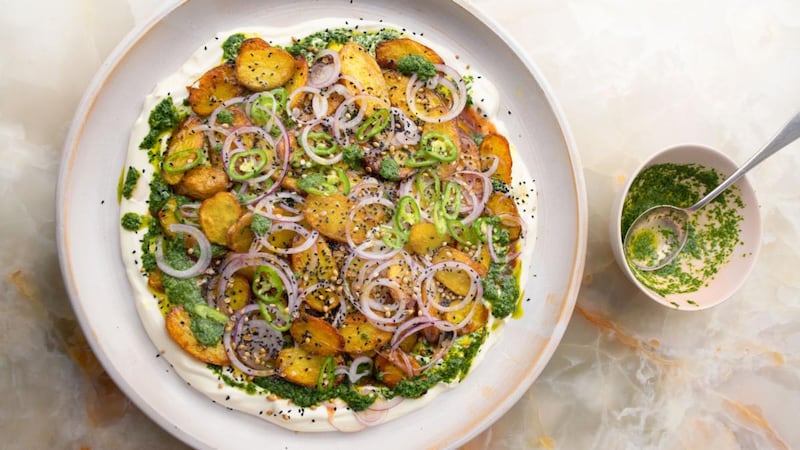I have no idea if Yotam Ottolenghi would have been up for giving me a virtual tour of his house in Camden, north London, but at least I get a glimpse of it on a Zoom call, before it crashes and we revert to a last-century phone call. It’s a beautifully proportioned room, impressive bookshelves on one side, vinyl records on the other, with a dramatic chandelier in blue hues that looks like Murano glass.
Sunlight streams through a window, and Ottolenghi, in a blue patterned shirt that integrates him perfectly into the scene, shows no evidence of a Covid stone. This is despite the fact that pasta was solidly on the menu for much of the lockdown months, requested repeatedly by his sons, Max (7) and Flynn (5), whom he has with his Northern Irish husband, Karl Allen.
Pasta bake was a favourite, which allowed him to work vegetables and chicken into their family meals, and with the release of his eighth cookbook, Ottolenghi Flavour, his adaptations of Italian dishes may just be something we will be hearing a bit more about in the coming weeks.
Jamie Oliver came under serious fire when chorizo rocked up in his “lubbly jubbly” paella; and as Ottolenghi moves his flavour compass to Italy, he risks attracting the wrath of the nonnas with za’atar cacio e pepe, traybake ragu, and fusion caponata with silken tofu. Allora!
“I hope they don’t mind. The idea is, you need to own up to what you do,” he says, amused at the thought. “The caponata has a slightly different flavour profile; there are ingredients in the caponata that move it a little bit eastwards on the map. But it all needs to make sense for me. The claim of authenticity is something that I rarely take. Authentic is a real stumbling block in terms of: how do you define if something is authentic?
“But I think playfulness and the ability to put the ingredients together is really important, because that’s the mother of innovation. And if we’re talking about that caponata, it is very clear to me that the tofu, inherently bland, is great at soaking up those flavours. And if I put a dollop of ricotta there, nobody would care that much. I think you need to be thoughtful about it, you need to stand behind what you’re doing, and then I think the Italians will follow, or at least some of them.”
'I wouldn't want to take credit for something that I have not been the sole creator of'
To chat to Ottolenghi like this is to get a glimpse of what fuels his imagination, his relentless curiosity and his desire to unearth ever more ways to roast a cauliflower, slice a tomato, squeeze a lemon and fry an aubergine. He is prolific and attributes this to the fact that most of his books are collaborations. With a test kitchen and six restaurants, he has plenty of talent to keep the creative stoves burning.
Unlike some high-profile chefs, who have been criticised for taking credit for every recipe that is generated under their watch, he nurtures talent. “It’s not just about bringing younger cooks into the picture, it’s a lot about getting inspired by other people, and I’d be the first to admit that,” he says.
“I love working in a group. I love conversations that come out of the group, and I wouldn’t want it any other way. I wouldn’t want to take credit for something that I have not been the sole creator of.”

Ixta Belfrage, who has worked with Ottolenghi for nearly four years, first in Nopi, followed by three years in the test kitchen, shares equal billing with him on Flavour.
Ottolenghi describes this book as the third in the Plenty series. The first, Plenty, represents the honeymoon period, with vegetables such as peppers, brassicas and aubergines getting a whole chapter to themselves. Plenty More is all about the process, looking at how vegetables are cooked – steamed, mashed, grilled, tossed. And Flavour is about understanding what makes vegetables distinct, and how things can be ramped up with “flavour bombs”.
Like many in the Ottolenghi stable, Belfrage’s upbringing has hugely influenced her approach to cooking. She has a Brazilian mother and English-American father who works with Italian wines, and she spent much of her childhood in Tuscany as well as Mexico, where her grandfather lived for 30 years.
Before joining Ottolenghi, she had not cooked with Middle Eastern ingredients such as tahini, sumac and za’atar, so as well as incorporating them into her dishes, she has introduced some of the ingredients more familiar to her, such as lime and chillies. These, and other dishes that have been developed over the past three years in the test kitchen, are what make up the backbone of Flavour.
As with every Ottolenghi cookbook, a new ingredient grabs the spotlight, and this one is no different. “Our chilli of the moment is Cascabel chilli. It’s a little round chilli and if you shake it, it rattles,” says Belfrage.
'With cooking, it's always about things in tandem'
The good news is, this chilli is available in Ireland – in Picado Mexican Pantry in Dublin. “It’s got smoky, chocolatey, fruity undertones, it’s not even that hot. I realise there are quite a lot of chillies in a lot of the recipes. We’ve got a recipe for tangerine and chilli flan, but in that context, it’s not really about the spice – it brings very mild undertones of spice – it’s about the extra flavours the chillies have. For example, Ancho chilli is sort of fruity and peppery, but it’s also smoky, so it brings that sort of element to the flan, and the Cascabel chilli brings a sort of chocolatey and peppery element, but it’s not very hot. I hope people aren’t put off by the amount of chillies we use because it doesn’t always mean that they’re spicy.”
For Ottolenghi, these spices add another layer to his signature way of building flavour. “We’re still talking about those big contrasting flavours and mixing and matching different influences and putting them together,” he says. “With cooking, it’s always about things in tandem. You can say that’s the predominant aspect of this particular dish, it’s about fat, or it’s about chillies, or nuts; but actually, it’s always all of these things together.
“It’s really interesting to say, ‘Okay, this is how you create a balance, this is how you create layering in a dish, where you put things together, and sometimes it’s contrasting.’ For instance, if something is very fatty and rich, if you add chilli heat to it, it balances itself out. One of them counteracts the other.”
Not only is Flavour filled with the sort of inventive recipes we expect from an Ottolenghi tome, it also looks in depth at the elements that contribute to great flavour – the process by which something is cooked, the alchemy of pairing different components, and the use of produce with heavy-hitting flavours. They are year-round recipes, too, with plenty for the cooler autumn months.
STUFFED AUBERGINE IN CURRY AND COCONUT DAL
Serves four as a main

Only two ingredients – lemon and milk – are what it takes to make paneer at home. It’s an experiment worth trying (it certainly feels like conducting a chemistry experiment), both for a sense of achievement and for unrivalled freshness. Yotam Ottolenghi has published a recipe in the Guardian, but many others are also available online. If you buy your paneer – which makes the most satisfying filling for the grilled aubergines here, as it soaks up the coconut sauce – try to find a soft variety, which has a texture like compressed ricotta. Other varieties, which are harder and slightly rubbery, are more suitable for making vegetarian tikka kebabs, but they will also do if that’s what you’ve got. For a vegan option, use extra-firm tofu. Try to get a good-quality, chunky Indian mango pickle for this. We use Fudco brand.
Both the aubergine slices and the lentil sauce can be prepared the day before, if you want to get ahead. In fact, you can make the whole dish a day ahead – up until before it goes into the oven, chill in the fridge and then just bring to room temperature before warming up.
Ingredients
3 large aubergines, stalks removed, each aubergine cut lengthways into six ½cm-thick slices (750g)
3tbs olive oil
220g paneer (or extra-firm tofu), roughly grated
2 limes: finely grate the zest to get 1tsp, then juice to get 2tbs
45g hot mango pickle, roughly chopped, plus extra to serve
5g coriander, roughly chopped, plus extra to serve
100g large (not baby) spinach leaves, stems removed (60g)
Salt and black pepper
Coconut dal:
3tbs olive oil
5 banana shallots, peeled and finely chopped (250g)
45g fresh ginger, peeled and finely chopped
2 red chillies, finely chopped
30 fresh curry leaves (if you can't get any, you can also do without)
1tsp black mustard seeds
1tsp ground cumin
1tsp ground coriander
½ tsp ground turmeric
2tsp medium curry powder
2tsp tomato paste
100g dried red lentils
1 x 400ml tin of coconut milk (at least 70 per cent coconut extract)
Method
1 Heat the oven to 220 degrees (fan).
2 In a large bowl, toss the aubergines together with the oil, three-quarters of a teaspoon of salt and a good grind of black pepper. Spread out on two parchment-lined baking trays and bake for 25 minutes, flipping halfway, until softened and lightly browned. Set aside to cool.
3 For the coconut dal, put two tablespoons of the oil into a large sauté pan on a medium-high heat. Once hot, add the shallots and fry for eight minutes, until golden. Add the ginger, half the chilli and half the curry leaves (if using), cook for two minutes, then add the spices, tomato paste and lentils.
Stir for a minute, then add the coconut milk, 600ml of water and three-quarters teaspoon of salt. Bring to the boil, then reduce the heat to medium and leave to simmer for 20 minutes, stirring once in a while, until the lentils are soft and the sauce is thick. Pour into a medium baking dish, about 28cm x 18cm, if making the aubergine rolls, and set aside.
4 In a small bowl, toss together the paneer, lime zest, mango pickle, tablespoon of lime juice, the coriander and one-eighth of a teaspoon of salt.
5 Place one spinach leaf on top of each slice of aubergine. Put a heaped teaspoon of the paneer mixture in the middle, then roll up the aubergine, from the thinner end at the top down to the thicker bottom end, so the filling is encased. Put the aubergine roll seam-side down in the lentil sauce, and repeat with the remaining aubergine slices, spinach and paneer. You should end up with about 18 rolls, all sitting snugly in the sauce. Press the rolls gently into the sauce, but not so far that they are submerged, and bake for 15-20 minutes, until the aubergine is golden-brown on top and the sauce is bubbling. Remove from the oven and leave to rest for five minutes.
6 Heat the remaining tablespoon of oil in a small pan on a medium-high heat. Add the remaining chilli and curry leaves and fry for a minute, until the curry leaves are crisp and fragrant. Spoon over the aubergine rolls, drizzle over the lime juice and serve with the coriander sprinkled on top.
ROASTED AND PICKLED CELERIAC WITH SWEET CHILLI DRESSING
Serves two as a main or four as a side

This dish features celeriac in two very different guises – slow-roasted and pickled – giving it textural contrast and flavour complexity that enables it to take centre stage in a vegetable feast.
You can make the dressing a day ahead, but don’t mix in the fried chilli and garlic until you’re ready to serve. You’ll make more pickle than you need, but it keeps in the fridge for three days and is great stuffed into sandwiches and toasties or tossed through a salad. If you don’t want to pickle a whole celeriac, use just half and roast the other half, instead.
Ingredients
Whole roasted celeriac:
1 large celeriac, hairy roots discarded (no need to peel) and scrubbed clean (900g)
60ml olive oil
Flaked sea salt
2 spring onions, finely sliced at an angle, to serve
5g picked Thai basil leaves, to serve
Method
1 Preheat the oven to 170 degrees (fan).
2 Pierce the celeriac with a fork all over about 40 times and place on a parchment-lined baking tray. Mix the oil and 1½ teaspoons of flaked salt, then rub the celeriac generously with the oil mixture. Roast for a minimum of 2¼ hours, or up to 2¾ hours, depending on the size of your celeriac, basting every 20 minutes or so, until the celeriac is deeply browned, soft all the way through and oozes a celeriac caramel.
3 Leave to rest for 15 minutes, then cut into eight wedges, brushing each cut side with the oil and caramel left on the tray (you may need to add a little more oil if there isn't enough to coat the cut sides).
Pickled celeriac:
1 medium celeriac, trimmed, peeled and cut into thin, 6cm-long batons (500g)
3 celery sticks, cut into thin 6cm-long batons (120g)
2 garlic cloves, skin on and crushed with the side of a knife
3 limes: finely shave the skin to get six strips, then juice to get 60ml
150ml rice vinegar
Sweet chilli dressing:
120ml sunflower oil
5 garlic cloves, very finely sliced
3 red chillies, finely sliced into rounds (30g)
2 whole star anise
1½tbs white or black sesame seeds, or a mixture of both, well toasted
2½tbs maple syrup
1tbs rice vinegar
60ml soy sauce
2tbs chives, finely chopped
Method
1 Combine all the ingredients for the pickled celeriac with 20g flaked salt in a large bowl and set aside for at least two hours, stirring now and then, while you prepare the rest of the dish. You can make this up to three days ahead and keep it refrigerated.
2 Heat the sunflower oil for the sweet chilli dressing in a small saucepan on a medium-high heat. Once very hot, add the garlic, chillies and star anise and fry for 2-2½ minutes, stirring to separate the garlic slices, until the garlic is crisp and pale golden (it will continue to colour after you take it out of the oil, so don't take it too far). Strain through a sieve set on top of a small heat-proof bowl to collect the oil. Set the fried chilli and garlic aside, to serve. Remove 80ml of the aromatic oil and reserve for another recipe. Combine the remaining 40ml of oil with all the remaining ingredients for the dressing.
3 Preheat the oven to 200 degrees (fan).
4 Place the roasted celeriac wedges on a parchment-lined baking tray, cut side up. Make sure they've been brushed with their cooking oil and celeriac caramel by this point, and if not, brush with some olive oil and a little maple syrup or honey. Roast for 20 minutes, or until golden-brown.
5 Arrange the wedges on a large platter and sprinkle with a little flaked salt.
6 Add the fried chilli and garlic to the dressing and spoon over and around the celeriac. Top with 200g of the pickled celeriac mixture, avoiding the pickling liquid, garlic and lime skin. Garnish with the spring onions and Thai basil, and serve.
CHAAT MASALA POTATOES WITH YOGURT AND TAMARIND
Serves four as a side

This dish is inspired by aloo chaat, an Indian street food that has many regional variations, all of which are not for the faint-hearted because they are loaded with sweet and sour and a fair bit of crunch. This is a slightly tamer version, though still pretty “noisy”, both in flavour and in looks. It’s absolutely perfect for a weekend lunch, alongside other vegetables, such as the aubergine with herbs and crispy garlic, or the radish and cucumber salad with chipotle peanuts. You can also serve it as a side with roasted lamb or chicken.
Chaat masala is the slightly tangy spice mix that gives this dish its distinctive flavour. It gets its sharpness from amchoor, dried mango powder, which is used widely in Indian cooking as a souring agent. You’d recognise the flavour from samosas and pakoras, where it is often used.
Both the coriander chutney and the tamarind sauce are great condiments to have on hand to brighten up sandwiches and wraps, to spoon over eggs, or to serve alongside tofu or fish. Double or triple them, if you like – the coriander chutney will keep in the fridge for up to a week and the tamarind sauce for up to two weeks.
Ingredients
750g baby new potatoes, cut lengthways into 1cm-thick slices
2tbs olive oil
1tsp chaat masala
½tsp ground turmeric
250g Greek-style yoghurt
½ small red onion, peeled and thinly sliced into rounds on a mandolin, if you have one, or by hand (45g)
1 green chilli, thinly sliced into rounds (10g)
1½tsp coriander seeds, toasted
1½tsp nigella seeds, toasted
Salt
Coriander chutney:
30g fresh coriander
1 green chilli, deseeded and roughly chopped (10g)
1tbs lime juice
60ml olive oil
Sweet tamarind dressing:
1½tbs shop-bought tamarind paste, or double if you're extracting it yourself from pulp
1½tsp caster sugar
½tsp chaat masala
Method
1 Preheat the oven to 220 degrees (fan).
2 Put the potatoes and two teaspoons of salt into a medium saucepan and top with enough cold water to cover by about 4cm. Place on a medium-high heat, bring to the boil, then simmer for six minutes, or until they're almost cooked through but still retain a bite. Drain through a sieve and pat dry, then transfer to a large parchment-lined baking tray and toss with the oil, chaat masala, turmeric, one-third of a teaspoon of salt and a good grind of pepper.
Roast, stirring once or twice, for 35 minutes, or until deeply golden.
3 Meanwhile, make the coriander chutney. Put all the ingredients and ½ teaspoon of salt into the small bowl of a food processor and blitz until smooth. Set aside until needed.
4 For the tamarind dressing, whisk together all the ingredients in a small bowl with 1½ teaspoons of water and set aside.
5 Spread the yogurt out on a large round serving platter. Top with the coriander chutney, swirling it through without completely incorporating. Drizzle with half the tamarind dressing, and top with the potatoes, onion and chilli. Drizzle over the remaining tamarind, then sprinkle over the seeds and serve.



















